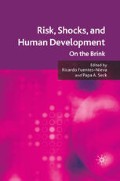Abstract
Although climate change is not limited to extreme events, the response of households to climate changes is most measurable in such events. Extreme climate events include flood, drought, wild fire, and many other types of natural disasters. Should households be affected by these events, they adjust their economic behaviors to cope with the changes in their environment and resources.
Access this chapter
Tax calculation will be finalised at checkout
Purchases are for personal use only
Preview
Unable to display preview. Download preview PDF.
References
Ablett, J. and Slengesol, I.-A. (2000). Education For All. Washington, DC: World Bank.
Bourguignon, F., Ferreira, F. H. G., and Lustig, N. (2004). The Microeconomics of Income Distribution Dynamics in East Asia and Latin America. Washington, DC: World Bank.
Buttenheim, A. (2006). “Flood Exposure and Child Health in Bangladesh.” California Center for Population Research, University of California Los Angeles. Working Paper.
Calves, A.-E. and Schoumaker, B. (2004). “Deteriorating Economic Context and Changing Patterns of Youth Employment in Urban Burkina Faso: 1980–2000.” World Development, vol. 32 (8): 1341–54.
Christiaensen, L. and Alderman, H. (2001). Child Malnutrition in Ethiopia: Can Maternal Knowledge Augment the Role of Income? World Bank, Africa Region Working Paper No. 22.
Dercon, S. (2005). Vulnerability: A Micro Perspective. Oxford: Oxford University Press.
Dercon, S. and Hoddinott, J. (2004) “Health, Shocks, and Poverty Persistence.” Insurance Against Poverty, vol. 1: 124–37.
Dercon, S., de Weerdt, J., and Beegle, K. (2007;. The Long-Run Impact of Orphanhood. World Bank, Policy Research Working Paper No. 4353.
Duflo, E. (2001). “Schooling and Labor Market Consequences of School Construction in Indonesia: Evidence from an Unusual Policy Experiment.” American Economic Review, vol. 91 (4): 795–813.
Duryea, S. (1998). Children’s Advancement through School in Brazil: The Role of Transitory Shocks to Household Income. Office of the Chief Economist, Working Paper No. 376. Inter-American Development Bank.
Ewoudou, J. and Vencatachellum, D. (2006). An Empirical Analysis of the Rates of Returns to Education in Cameroon. Working Paper. African Development Bank.
Fafchamps, M., Udry, C., and Czukas, K. (1998). “Drought and Saving in West Africa: Are Livestock a Buffer Stock?” Journal of Development Economics, vol. 55 (2): 273–305.
Gertler, P., Levine, D., and Ames, M. (2004). “Schooling and Parental Death.” Review of Economics and Statistics, vol. 86 (1): 211–25.
Heckman, J., Lochner, L., and Todd, P. (2003). Fifty Years of Mincer Earnings Regressions. NBER Working Papers No. 9732.
Hoddinott, J. and Kinsey, B. (2001). “Child Health in the Time of Drought.” Oxford Bulletin of Economics and Statistics, vol. 63: 409–36.
Hoddinott, J. and Quisumbing, A. (2003). Methods for Microeconometric Risk and Vulnerability Assessments. Social Protection Discussion Paper 0324. World Bank.
Hoogeveen, J., Tesliuc, E., Vakis, R., and Dercon, S. (2008). A Guide to the Analysis of Risk, Vulnerability and Vulnerable Groups. Working Paper. World Bank.
Heady, C. (2003). “The Effect of Child Labor on Learning Achievement.” World Development, vol. 31 (2): 385–98.
Jacoby, H. and Skoufias, E. (1997). “Risk, Financial Markets, and Human Capital in a Developing Country.” Review of Economic Studies, vol. 64 (3): 311–35.
Jensen, R. (2000). “Agricultural Volatility and Investments in Children.” American Economic Review, vol. 90 (2): 399–404.
Maccini, S. and Yang, D. (2008). Under the Weather: Health, Schooling, and Economic Consequences of Early-Life Rainfall. Working Paper.
Orazem, P. and Gunnarsson, V. (2003). Child Labour, School Attendance and Performance: A Review. International Labour Office, International Programme on the Elimination of Child Labour.
Organization for Economic Co-operation and Development (OECD) (2006). Education at a Glance. Paris.
Psacharopoulos, G. (1997). “Child labor versus educational attainment Some evidence from Latin America,” Journal of Population Economics, Springer, vol. 10 (4), pages 377–386.
Psacharopoulos, G. and Patrinos, H. A. (1997). “Family Size, Schooling and Child Labor in Peru — An Empirical Analysis.” foumal of Population Economics, vol. 10 (4): 387–405.
Rawlings, L. and Rubio, G. (2003). Evaluating the Impact of Conditional Cash Transfer Programs: Lessons from Latin America. World Bank, Policy Research Working Paper Series No. 3119.
Rosati, F. and Rossi, M. (2001). “Children’s Working Hours, School Enrolment and Human Capital Accumulation: Evidence from Pakistan and Nicaragua.” UCW Working Paper 8, Understanding Children’s Work (UCW Project). George Psacharopoulos, 1997.
Sánchez, M. A., Orazem, P. F., and Gunnarsson, V. (2005). “The Effect of Child Labor on Mathematics and Language Achievement in Latin America.” Social Protection Discussion Paper Series No. 0516. Washington DC: The World Bank.
Sedlacek, G., Duryea, S. Ilahi, N., and Sasaki, M. (2003). “Child Labour, Schooling, and Poverty in Latin America,” in Peter F. Orazem, Zafiris Tzannatos, and Guilherme Sedlacek (ed.), Child Labor and Education in Latin America: An Economic Perspective. Basingstoke: Palgrave Macmillan.
Skoufias, E. and Shapiro, J. (2006). Evaluating the Impact of Mexico’s Quality Schools Program: The Pitfalls of Using Nonexperimental Data. World Bank, Policy Research Working Paper Series No. 4036.
United Nations Development Programme (UNDP) (2007). Human Development Report, Fighting Climate Change: Human Solidarity in a Divided World.
Vos, R. and De Jong, N. (2003). “Trade Liberalization and Poverty in Ecuador: A CGE Macro-Microsimulation Analysis.” Economic Systems Research, vol. 15 (2): 211–32.
Weidman, J. (2001). “Developing the Mongolian Education Sector Strategy 2000–2005: Reflections of a Consultant for the Asian Development Bank.” Current Issues in Comparative Education, vol. 3 (2).
World Bank (2000). World Development Report 2000/2001: Attacking Poverty. Washington DC.
World Bank (2007). World Development Indicators. Washington DC.
Author information
Authors and Affiliations
Editor information
Editors and Affiliations
Copyright information
© 2010 United Nations Development Programme
About this chapter
Cite this chapter
Kim, N. (2010). Impact of Extreme Climate Events on Educational Attainment: Evidence from Cross-Section Data and Welfare Projection. In: Fuentes-Nieva, R., Seck, P.A. (eds) Risk, Shocks, and Human Development. Palgrave Macmillan, London. https://doi.org/10.1057/9780230274129_8
Download citation
DOI: https://doi.org/10.1057/9780230274129_8
Publisher Name: Palgrave Macmillan, London
Print ISBN: 978-1-349-58785-8
Online ISBN: 978-0-230-27412-9
eBook Packages: Palgrave Social Sciences CollectionSocial Sciences (R0)

